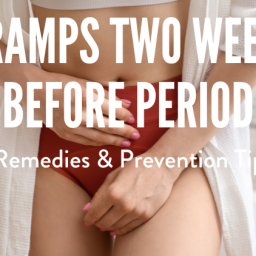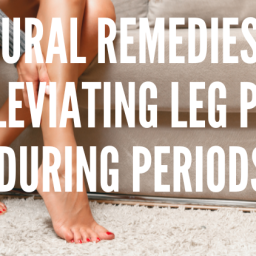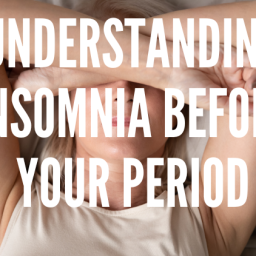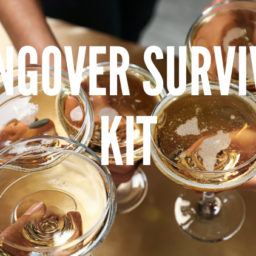
Periods!
They arrive more or less every month, but they never fail to turn our worlds at least a little upside down.
Food cravings, bloating, and breakouts are all par for the course if you’re still on your cycle, with symptoms being more or less severe depending on a number of factors.
Period back pain is another lovely present you might regularly receive from Aunt Flo.
It might even be shark week for you right now, and you’re noticing that “oh, yeah, I do get the same ache in my back every month!”
If you’re curious about period back pain, its causes, and how to manage it, this blog is for you.
Understanding Period Back Pain
The connection between period back pain and menstruation isn’t a direct line.
Instead, it’s more of a ripple effect.
When you get your period, your uterus contracts to expel the uterine lining that has built up over previous weeks.
The pressure these contractions can put on surrounding structures can cause pain, which radiates to the lower back.
Hormones like prostaglandin can trigger even stronger and more painful uterine contractions, which ripple across the pelvic area and lower back.
Plus, the heightened level of inflammation some women experience during their periods can contribute to back pain.
While lower back pain and pelvic pain might both occur during menstruation (how fun!) they’re not actually the same. Lower back pain is centered around the lower spine, radiating across the back. It can have multiple causes unrelated to menstruation, like poor posture, herniated discs, and spinal issues.
Pelvic pain, by contrast, is felt in the lower abdominal area, and can also be unrelated to menstruation, though its causes include conditions like endometriosis and adenomyosis.
Let’s explore some of the causes of period back pain, shall we?
Causes of Period Back Pain
Primary Dysmenorrhea
Period back pain can manifest in both primary and secondary dysmenorrhea.
“Dysmenorrhea”, the medical term for painful periods, covers both primary (more mild) and secondary (more severe) causes.
Primary dysmenorrhea, which is experienced by 90% of menstruating women, refers to menstrual cramps that happen without any underlying medical conditions. These mild to moderate cramps begin 1-2 days before menstruation, lasting 2-4 days total.
These cramps feel achy and dull, and are caused by those uterine contractions we referred to. And since we know that contractions can put pressure on surrounding organs, boom – there’s your period back pain. In fact, 16% of one group of women 18-25 reported period back pain associated with their dysmenorrhea.
Period back pain associated with primary dysmenorrhea (say that 3 times fast) can also be linked to hormonal fluctuations, which intensifies the perception of pain during menstruation.
Secondary Dysmenorrhea
Secondary dysmenorrhea, on the other hand, is characterized by menstrual cramps that do have an underlying condition.
It can start later in life, and be significantly more severe than primary dysmenorrhea.
What sort of underlying condition, exactly?
Endometriosis, fibroids, adenomyosis, or pelvic inflammatory disease (PID) are all culprits. In contrast to its more mild cousin, pain may begin several days before menstruation and continue well past the end of a period.
Heavy menstrual bleeding, irregular periods, and pain during sex are also common symptoms – not to mention, a more severe version of period back pain.
If you suspect that your period back pain is being caused by something besides uterine cramps, it’s best to consult a medical professional for the full picture.
Severe period pain is also associated with another condition, a severe version of PMS called PMDD, or Premenstrual Dysphoric Disorder. About 2-6% of women of childbearing age deal with PMDD, and lower back pain is part of it.
Since secondary dysmenorrhea comes with an underlying cause, treating it involves treating the condition that causes it. The period back pain that comes with it might respond to over-the-counter medications, but a proper determination of its severity is best performed by a medical professional.
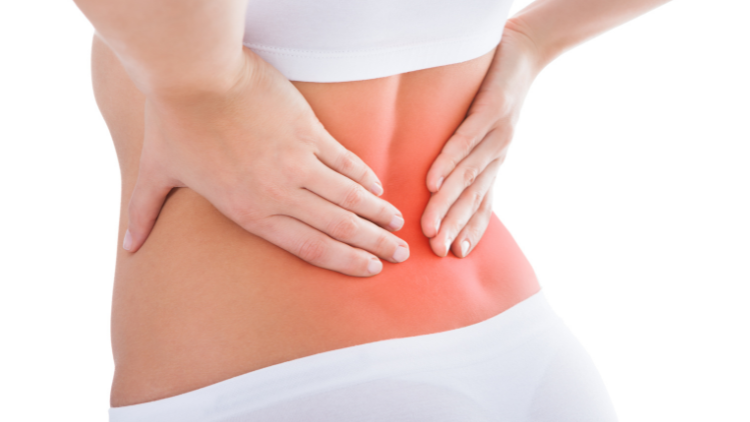
Identifying and Managing Period Back Pain
Lifestyle Modifications
We know period pain can bring the doom and gloom, so we’ve put together a list of treatments you can try when it’s your time of the month.
Might sound like a broken record, but staying hydrated goes a long way into helping your muscles work properly – that includes the muscles of the uterus!
Plus, if you know that you’re a bit sensitive to gluten, dairy, or other foods when you’re not on your period, you might want to skip those when you are. Give yourself a fighting chance, right?
In general, laying off the salt and caffeine can certainly help, as well as restricting your alcohol intake.
Basically, if it makes you feel like crap any other week, maybe don’t make it part of your period regime.
Heat Therapy
Studies have shown that, overall, 80% of women experience period cramps.
Of those, not all use heat to relieve their cramps, but it can certainly help.
The reason heat therapy can work so well, especially for pain caused by primary dysmenorrhea, is because heat increases blood flow when applied to a specific area, which relaxes muscles.
Using that same logic, one theory suggests that heating pads relax the muscle wall, or myometrium, found in the uterus.
Applying the pad to the lower abdomen is usually how heat therapy works with periods, but if you suffer from period back pain, you might also want to try laying on a heating pad.
Experiment to see what’s right for you!
Over-the-Counter Pain Relief
If you have too much going on to sit around with a heating pad, over-the-counter pain medication might be one way to go.
NSAIDs, acetaminophen, or combination drugs are all recommended by the American College of Obstetricians and Gynecology, to be taken until day 2 or 3 of bleeding.
Nothing replaces advice from your personal health professional – we just want you to have the facts.
You may know these drugs by their common names, like Advil, Aleve, Tylenol, or Midol. Some drugs, like Midol, do contain caffeine – so check the bottle and dosage amounts before trying them out!
Complementary Therapies
So, you’re staying hydrated, getting enough sleep, and exercising.
But your periods are leaving a lot to be desired, not to mention the period back pain.
Did you know that having an orgasm is one way to get some relief from cramps and aches?
Acupuncture and abdomen massage are also complementary therapies that you can pair with any other dietary or lifestyle changes you’re making…but the whole orgasm thing doesn’t sound bad at all.
Prescription Medications
We’re not here to recommend any prescription medications.
But, if you do find that your period pain is severe, and aligns more closely with secondary dysmenorrhea or PMDD, you might want to speak with your doctor and see what treatment options are available for you.
Depending on your underlying condition, they may suggest hormone therapies, medication, surgery, lifestyle changes, or some combination of these.
Medications like tranexamic acid are used to manage heavy blood flow during a period, while birth control (aka, The Pill) can also be used to regulate a period.
Of course, you can’t get access to therapies like these without a prescription – so talk to your doctor.
Natural & Dietary Supplements
Ginger and turmeric are those no-brainer, “why not” dietary supplements everyone seems to be trying.
And for good reason – both turmeric and ginger reduce inflammation and are easily added to your diet, in savory/sweet cooking or in beverages.
Golden milk, or turmeric milk lattes, are popular, and ginger tea is easy to find at the store. Ginger is also thought to reduce prostaglandin production in the body, reducing the crampiness none of us love.
THC Period Suppositories
While we always encourage speaking to a healthcare professional, there’s one area of expertise we pride ourselves in: THC and CBD vaginal suppositories.
If you’re dealing with period pain during periods or general pain and are looking for a way to manage it without resorting to over-the-counter drugs, our THC period suppository might be perfect for you.
With cocoa butter, avocado oil, and marula oil for moisture, plus lemon balm, sweet thyme, and pine needle extract, our suppositories combine cannabis with natural botanicals to ease your monthly woes.
Our period suppository is also balanced at a 1:2 THC:CBD ratio, meaning there’s twice as much CBD as THC inside. It’s been formulated so that the CBD counteracts some of THC’s psychoactive effects, resulting in a more relaxed, full-body “high”.
Your own experience may vary!
Self-Care Tips for Managing Period Back Pain
When you’re in the thick of period back pain, it can be tricky to remember what you’ve tried, what worked, and for how long.
One way to keep your brain clear is to maintain a pain diary, to track symptoms from period to period. You can come up with your own rating system to determine how difficult or easy your period is, and eventually you’ll see patterns start to emerge.
For example, if you know the first 1-3 days of your period are the worst, you’ll know to reach for what works.
And if you’re still trying to figure out what works, all the more reason to keep a diary or tracker. Then, you can see what you liked, what you won’t try again, and what you’re curious about.
The goal is to make your life easier, not harder, during your period. So while eating well, sleeping enough, and staying hydrated are basic prerequisites to daily life, they become even more important during your period.
When to Seek Medical Attention
If your menstrual pain, or period back pain is so bad that you can’t live a normal life or do what you want to do, you’ll want to talk to your doctor.
Also, if your period-related back pain is a new or unusual symptom for you, you’ll want to seek medical advice. This is especially valid if you’re experiencing other symptoms like heavy bleeding, irregular periods, or radiating pain that you can feel in other parts of your body that have nothing to do with your period.
Nausea and vomiting also count as unusual symptoms, as well as any change to your appetite, your bathroom rhythms, or even pain during sex.
Basically, if it’s new, weird, or awful for you – talk to your doctor.
Conclusion
Knowing what’s coming goes a long way to managing anything in life, but especially chronic period back pain.
Especially when your period back pain is coming from primary or secondary dysmenorrhea, PMS, or even PMDD.
That’s why we suggest using a diary, taking good care of yourself, and keeping an open mind when it comes to trying new things that might help you.
Taking good care of yourself also means seeking the advice and assistance of a medical professional. Periods can be a bit awkward to bring up, but hey, we’ve probably used the word
50 times in this blog post alone. You can do it!
You are your own best advocate, and we’re here to support you.
Sources
1. https://healthmatch.io/lower-back-pain/lower-back-pain-on-my-period
2. https://www.healthcentral.com/condition/back-pain/period-back-pain
3. https://www.ncbi.nlm.nih.gov/pmc/articles/PMC4535108/
4. https://healthmatch.io/lower-back-pain/lower-back-pain-on-my-period
5. www.thewomens.org.au/health-information/periods/healthy-periods/exercise-diet-periods
6. https://www.getrael.com/blogs/r-blog/using-a-heating-pad-for-cramps
7. https://www.goodrx.com/conditions/menstrual-pain/best-otc-for-menstrual-cramps
8. https://www.medicalnewstoday.com/articles/324484#heat
9. www.thewomens.org.au/health-information/periods/heavy-periods
10. https://mothercuppatea.com/blogs/our-blog/5-drinks-that-help-with-period-cramps
11. https://helloagainproducts.com/period-suppository/
12. https://www.healthdirect.gov.au/managing-period-pain# 13. https://helloagainproducts.com/

